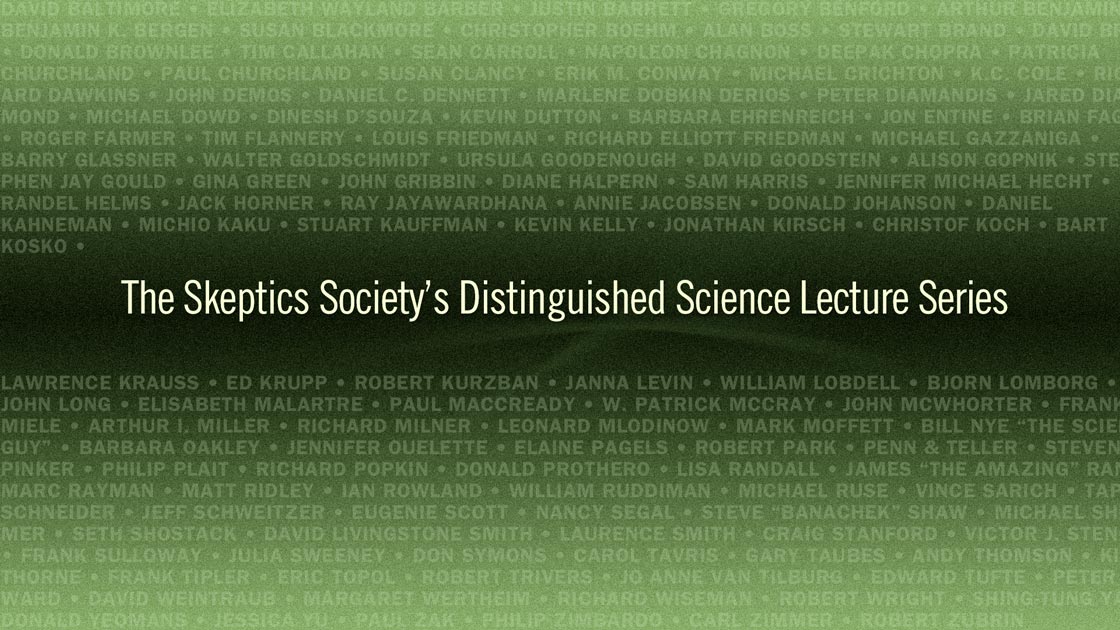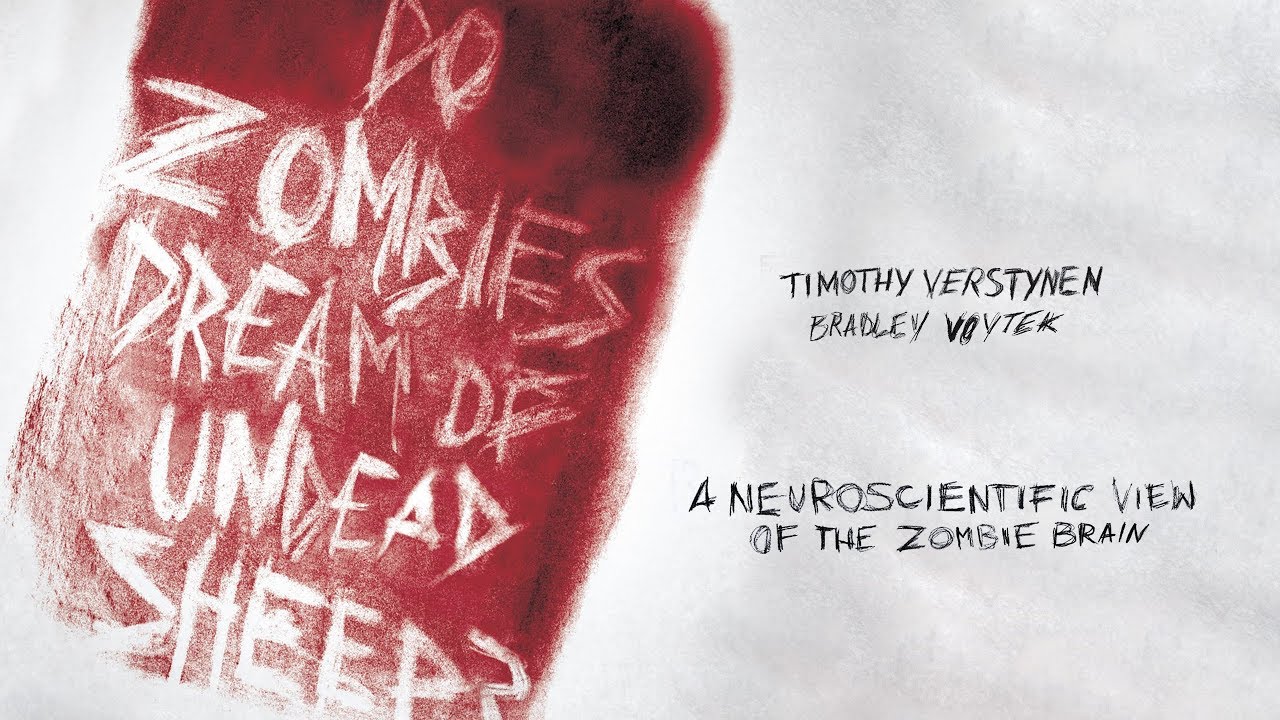In this week’s eSkeptic:
- Don’t Miss Bill Nye, the Science Guy: in Conversation with M. Shermer
- Distinguished Science Lecture: Dr. Bradley Voytek — Do Zombies Dream of Undead Sheep? A Neuroscientific View of the Zombie Brain
- Scientific American “Skeptic” column Jan. 2015: Here Be Zombies
- Feature: The 1919 Theory That Explains Why Police Officers Need Their Guns
Don’t miss BILL NYE, the Science Guy
in conversation with Michael Shermer, discussing Bill’s new book: Undeniable: Evolution and the Science of Creation


Sun., Jan. 25, 2015 at 2 pm
Beckman Auditorium
SPARKED BY A CONTROVERSIAL DEBATE in February 2014, Bill Nye has set off on an energetic campaign to spread awareness of evolution and the powerful way it shapes our lives. In Undeniable: Evolution and the Science of Creation, he explains why race does not really exist; evaluates the true promise and peril of genetically modified food; reveals how new species are born, in a dog kennel and in a London subway; takes a stroll through 4.5 billion years of time; and explores the new search for alien life, including aliens right here on Earth. With infectious enthusiasm, Bill Nye shows that evolution is much more than a rebuttal to creationism; it is an essential way to understand how nature works—and to change the world. Don’t miss this enlightening “In Conversation” with Bill Nye, hosted by Michael Shermer.
A book signing will follow the lecture. We will have copies of the book, Undeniable: Evolution and the Science of Creation, available for purchase. Can’t attend the lecture? Order Undeniable from Amazon.
Ticket Information
Tickets are $15 for Skeptics Society members/Caltech/JPL community; $20 for general public; $5 for Caltech students. Tickets may be purchased in advance through the Caltech ticket office in 101 Winnett, at the door, by calling at 626-395-4652 between 9am and 4pm Monday through Friday (Do not leave a message.), or online using the link below. Ordering tickets ahead of time is strongly recommended.
DISTINGUISHED SCIENCE LECTURE
Dr. Bradley Voytek — Do Zombies Dream of Undead Sheep? A Neuroscientific View of the Zombie Brain
With their endless wandering, lumbering gait, insatiable hunger, antisocial behavior, and apparently memory-less existence, zombies are the walking nightmares of our deepest fears. What do these characteristic behaviors reveal about the inner workings of the zombie mind? Could we diagnose zombism as a neurological condition by studying their behavior? In Do Zombies Dream of Undead Sheep?, Dr. Bradley Voytek, a professor of computational cognitive science and neuroscience at the University of California, San Diego, applies neuro-know-how to dissect the puzzle of what has happened to the zombie brain to make the undead act differently than their human prey. Combining tongue-in-cheek analysis with modern neuroscientific principles, Voytek shows how zombism can be understood in terms of current knowledge regarding how the brain works. Voytek draws on zombie popular culture and identifies a characteristic zombie behavior that can be explained using neuroanatomy, neurophysiology, and brain-behavior relationships. Through this exploration he sheds light on fundamental neuroscientific questions such as: How does the brain function during sleeping and waking? What neural systems control movement? What is the nature of sensory perception? Order Do Zombies Dream of Undead Sheep? from Amazon.
You play a vital part in our commitment to promote science and reason. If you enjoyed this Distinguished Science Lecture, please show your support by making a donation.

NEW SCIENTIFIC AMERICAN COLUMN ON MICHAELSHERMER.COM
Here Be Zombies
In Michael Shermer’s January 2015 “Skeptic” column for Scientific American, he discusses our fear of and fascination with zombies—those liminal beings that fall in between categories (animate and inanimate, human and nonhuman)—and what the living dead can teach us about ancient prejudices.
![Free iStock photo from 2011 by Inkret [http://www.istockphoto.com/profile/inkret] (See: http://www.istockphoto.com/photo/old-west-sheriff-badge-10892293)](https://www.skeptic.com/eskeptic/2015/images/15-01-07/iStock_000010892293_freebie.jpg)
About this week’s eSkeptic
In this week’s eSkeptic, Michael Shermer discusses race relations and the law in America through the lens of Max Weber’s 1919 theory on “legitimate use of physical force.” A slightly different version of this OpEd was originally published at Time.com on December 23, 2014.
Michael Shermer is publisher of Skeptic magazine and a monthly columnist for Scientific American. His new book, The Moral Arc: How Science and Reason Lead Humanity Toward Truth, Justice, and Freedom, comes out on January 20, 2014. Follow him on Twitter @michaelshermer.
The 1919 Theory That Explains Why Police Officers Need Their Guns
by Michael Shermer
In 1919, with the smoke still clearing from the battlefields of the First World War, the German sociologist Max Weber began a systematic study of the nation-state by defining a state as any “human community that successfully claims the monopoly of the legitimate use of physical force within a given territory.” But what constitutes legitimate force? We should keep this question in mind when considering the run of recent events involving conflicts between police and citizens, from the killing of two unarmed black men by cops in Ferguson, Mo., and Staten Island, N.Y., earlier last year, as well as the murder of two police offers in New York City in December.
Over the course of many centuries the criminal justice system, with its armed police, replaced self-help justice conducted by gangs and individuals. Human communities such as drug gangs and mafia syndicates use physical force, but it is not legitimate and they do not have a monopoly; this leads to higher rates of violence because there is no strong state to act as an objective third party to oversee disputes. In Mexico, for example, the high incidence of violence can be traced in part to the inability of the state to enforce its drug laws, leading gangs to settle their differences themselves. States, for all their faults, have more checks and balances than individuals. This is why Justitia—the Roman goddess of justice—is often depicted wearing a blindfold (symbolizing impartiality) and carrying a scale on which to weigh the evidence in one hand and a double-edged sword, for her power to enforce the law, in the other.
Today the state’s justice is conducted through two systems: criminal and civil. Civil justice deals with disputes between individuals or groups, whereas criminal justice deals with crimes against the laws of the land that are punishable only by the state. This is why criminal cases are labeled The State v. John Doe or The People v. Jane Roe: the state is the injured party. California, for example, continues to pursue charges against the filmmaker Roman Polanski for allegedly raping an underage girl in 1977, even though she—a woman now in her 40s—has requested that the state drop the charges. In late December 2014 he filed another motion to have all charges against him dropped, and Geimer has even offered to testify on his behalf, but the state of California is unlikely to drop the charges because that would show weakness in its commitment to the rule of law.
That’s why people sometimes take the law into their own hands, via vigilantism or protest, when they do not feel that the law is fair to them: because the criminal-justice system acts on behalf of only the state, rather than on behalf of individuals, it requires trust in the state in order to work. That trust is lacking for many black communities in America; a 2013 Gallup poll, for example, found that 25% of whites but 68% of blacks believe that “the American justice system is biased against black people.”
This theory is important to keep in mind when thinking about what happened between 12:01pm and 12:03pm on Aug. 9, 2014, in Ferguson, Mo., when police officer Darren Wilson shot and killed teenager Michael Brown. Was his use of physical force legitimate or not? A grand jury determined that it could not make such a determination based on the conflicting eyewitness accounts, and so Wilson’s actions will not be considered criminal by the state. Something similar happened in New York when Eric Garner died at the hands of the police—was it a legal “grappling hold” or “headlock” or an illegal chokehold? Even with video evidence the grand jury voted not to indict the police officers, based on a medical examination that concluded Garner’s death was not due to damage to the windpipe or neck bones, but was the result of compression to the neck and body in conjunction with asthma, heart disease and obesity. Though Brown’s and Garner’s families may choose to pursue civil cases, only the state can say—or, as the case may be, not say—that a crime has been committed.
Though much remains unclear about what happened in these situations, Weber’s theory can also help us understand how a seemingly innocent encounter between a citizen and a police officer could escalate into lethal violence. When Officer Wilson asked Michael Brown to move from the middle of the street to the sidewalk and Brown refused, Wilson was faced with the dilemma all cops face when a suspect refuses to comply: back down and thereby lose both the monopoly and the legitimacy of law enforcement, or ratchet up the intensity of tactics to achieve compliance. The latter is what happened on that fateful day when Brown not only refused to comply with Wilson’s demand, but—according to some reports—also reached into his squad car to grab his gun. As a former Baltimore police officer and police commissioner named Fred Bealefeld told the New York Times “If someone grabs your weapon, as a cop you’re not thinking they are going to scare you with it. In my mind, every time someone tried to grab my gun in the street, they were going to try to kill me. That encounter changes everything.” The case of Eric Garner was similar in that when he was approached by the police on suspicion of selling single cigarettes without tax stamps, he responded by complaining of being harassed by the police. In response, the police moved to arrest Garner by physically grabbing him, which he also resisted, leading to an escalation of violence and his death.
In a world where Weber’s theory is in effect, allowing a civilian to potentially use force against the police is a challenge to the whole fabric of society. Though it’s possible to debate how much police force is legitimate, any non-police force is inherently illegitimate. This is why the killing of two New York City police officers—40-year old Rafael Ramos and 32-year old Wenjian Liu—on December 20 is likely to shift the sympathies of the public away from the peaceful protesters marching against injustice and back toward the police, especially after news reports surfaced that the alleged shooter, Ismaaiyl Brinsley, posted on social media that it was in retaliation for the deaths of Michael Brown and Eric Garner (the killer took his own life shortly after the shootings). This is most likely a one-off event unlikely to be repeated in cities across the U.S., but it nonetheless punctuates the point that there’s a reason the police in all civilized states are armed in one way or another.
The deaths of Michael Brown, Eric Garner, Rafael Ramos and Wenjian Liu were tragedies that need this kind of perspective, because in fact the vast majority of law enforcement officers are good people just trying to do their jobs of administering the state’s rule of law, and the vast majority of African-Americans are good people just trying to lead their lives without hassle from law enforcement. That these two communities occasionally collide in this manner is tragic, but a bit more historical perspective shows that this is far less common than it used to be.
Urban violence from the 1950s through the 1980s was commonplace, a regular feature on the nightly news; it’s now mostly relegated to historical documentaries featuring black-and-white footage of fire hoses and police dogs. And racist attitudes of Americans really are on the decline. Polling data show, for example, that in the 1940s nearly three-quarters of Americans agreed that “black and white students should go to separate schools.” That figure collapsed to almost zero by 1995, when pollsters quit asking the question. In 1960 almost half of all white Americans said that they would move if a black family moved in next door. Today that figure is also close to zero. At the turn of the 20th century lynchings were commonplace, averaging a couple a week through the 1920s, finally coming to an end by the 1950s, as shown by data from the Oxford University economist Max Roser. A 2013 Gallup poll on interracial marriage also shows the positive trend in tolerance over the past half century; in keeping with other rights revolutions where age is a factor in becoming more tolerant, the approval rate of interracial marriage in this study was 96% among 18– to 29-year-olds, 93% of 30– 49-year-olds, 84% of 50– to 64-year-olds, and 70% of 65 year olds and older. And think about the case of Donald Sterling, forced to sell his basketball team, the Clippers, for racist remarks he made in private to his mistress. In the 1950s an old white guy who thought of blacks like Sterling seems to today wouldn’t have needed to be especially private about his prejudices. Today, the few who still think like this mostly keep it to themselves or publish their views in fringe white supremacist newsletters or web sites.
Clearly, as recent events have shown, racial violence is not zero and we have a ways to go before America is truly color blind, but, as the oft-quoted Martin Luther King line says, the arc of the moral universe really is bending toward justice. It would be good to keep that fact in mind when watching the daily news. There’s good reason for our police to be armed, and reason for the officers to be able to use their weapons, and for the most part they apply that force judiciously—and, with that in mind, we can continue working on refining what is meant by Weber’s “legitimate use of force” to insure that it is rational, reasonable and applied to everyone equally. ![]()












